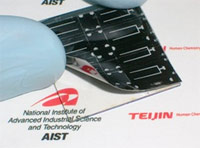Japan’s National Institute of Advanced Industrial Science and Technology (AIST) announced that that it confirmed a cell conversion efficiency of 17.7% from a CIGS solar cell with a flexible substrate, according to an article in TechOn Nikkei. The efficiency of the solar cell is reportedly one of the highest in the world for flexible CIGS solar cells. AIST noted in the article that instead of varying the amount of relatively unstable alkali metals such as sodium selenide or sodium fluoride to control the carrier density of a p-type semiconductor, its researchers developed the “alkali-silicate glass thin layer (ASTL) method." In this method, a silicate glass layer is formed on the substrate. Adjusting the conditions of the silicate glass layer for forming the film helps vary the amount of alkali metal that passes through the backside electrode layer and diffuses into the light absorbing layer. The company notes that this method increases the reproducibility of the process and improves the conversion efficiency of the solar cells.
method, a silicate glass layer is formed on the substrate. Adjusting the conditions of the silicate glass layer for forming the film helps vary the amount of alkali metal that passes through the backside electrode layer and diffuses into the light absorbing layer. The company notes that this method increases the reproducibility of the process and improves the conversion efficiency of the solar cells.
AIST tested three kinds of substrates: a ceramic substrate, a plastic film from Teijin Ltd., and a titanium foil with a rough surface. A conversion efficiency of 17.7% was achieved using the ceramic substrate. Using the plastic film achieved 14.7% efficiency and using the Ti foil achieved 17.4% efficiency. The technology will be showcased at the 4th Annual Symposium of Research Center for Photovoltaics from July 28-29, 2008, at the National Museum of Emerging Science and Innovation.

